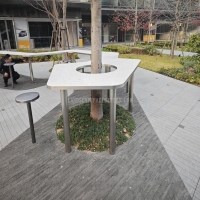Welcome to the website for landscape facilities products and knowledge.
How does the table’s design address potential issues with surface condensation in cold weather?
Outdoor table designers employ several strategic approaches to combat surface condensation during cold weather conditions. The fundamental principle involves managing temperature differentials between the table surface and the surrounding environment. Many premium outdoor tables incorporate specialized materials with low thermal conductivity, such as certain composite polymers or treated woods, which resist rapid temperature changes that cause condensation.
Advanced table designs often feature slightly sloped surfaces that encourage water droplets to run off rather than pool. This subtle angling, sometimes barely noticeable to the eye, proves highly effective in preventing standing moisture that can lead to surface damage or microbial growth. Additionally, many manufacturers integrate thermal break technology within the table structure, creating a barrier that minimizes heat transfer from the interior to the exterior surface.
Surface treatments represent another crucial design element. Nano-coatings and specialized sealants create hydrophobic surfaces that cause water to bead up and roll away. These microscopic treatments fill the porous structure of materials like concrete or natural stone, leaving no foothold for moisture absorption. Some manufacturers even incorporate mild surface textures that disrupt the formation of uniform condensation layers, encouraging droplets to coalesce and drain more efficiently.
The integration of passive ventilation systems in some table designs addresses condensation from another angle. Strategically placed gaps in the framework or perforated sections allow air circulation beneath and around the table surface, equalizing temperatures and reducing the likelihood of moisture formation. This approach proves particularly effective for tables with solid tops that might otherwise trap cold air.
Material selection remains paramount in condensation management. Designers increasingly favor materials with inherent moisture-resistant properties, including certain metal alloys with protective oxide layers, marine-grade polymers, and thoroughly sealed hardwoods. These materials not only resist condensation but also withstand the freeze-thaw cycles that can exacerbate moisture-related damage in colder climates. Through these multifaceted design strategies, modern outdoor tables maintain their functionality and appearance despite challenging weather conditions.
Related search:

Recommendation
An outdoor bar counter with stainless steel and terrazzo materials in an irregular shape